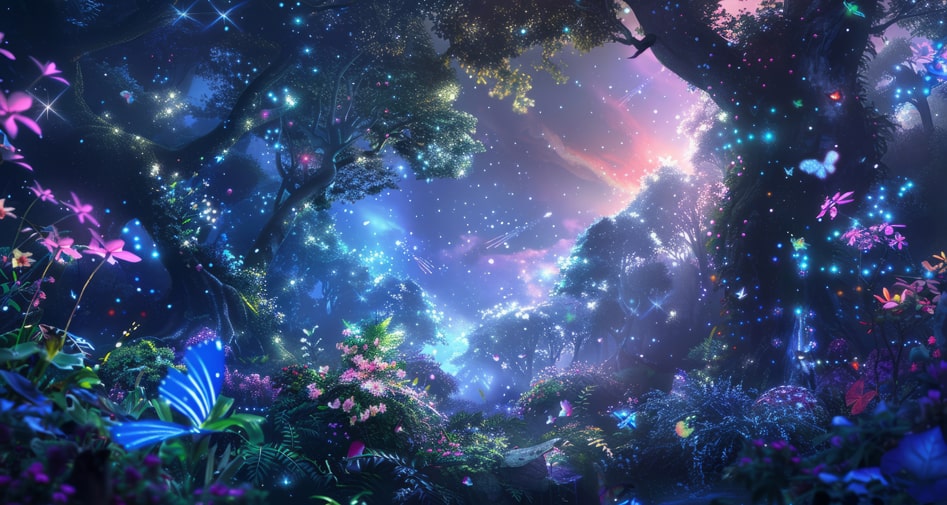Reading time: 14 min
In the middle of a garden grew a rose tree; it was full of roses, and in the loveliest of them all lived an elf. He was so tiny that no human eye could see him. He had a snug little room behind every petal of the rose. He was as well made and as perfect as any human child, and he had wings reaching from his shoulders to his feet. Oh, what a delicious scent there was in his room, and how lovely and transparent the walls were, for they were palest pink, rose petals. All day he revelled in the sunshine, flew from flower to flower, and danced on the wings of fluttering butterflies. Then he would measure how many steps he would have to take to run along all the high roads and paths on a linden leaf. These paths were what we call veins, but they were endless roads to him. Before he came to the end of them the sun went down, for he had begun rather late.
It became very cold, the dew fell and the wind blew; it was high time for him to get home. He hurried as much as ever he could, but the rose had shut itself up, and he could not get in, not a single rose was open. The poor little rose elf was dreadfully frightened, he had never been out in the night before; he had always slept so safely behind his cosy rose leaves. Oh, it would surely be his death!
At the other end of the garden he knew there was an arbour covered with delicious honeysuckle, the flowers looked like beautiful painted horns. He would get into one of those and sleep till morning.
He flew along to it. Hush! There were already two people in the arbour, a young handsome man and a lovely maiden. They sat side by side and wished they might never more be parted, so tenderly did they love each other. They loved each other more dearly than the best child can even love its father and mother.
“Still, we must part,” said the young man; “your brother is not friendly to us, therefore he sends me on such a distant errand, far away over mountains and oceans. Good-bye, my sweetest bride, for you are that to me you know!”
Then they kissed each other, and the young girl wept, and gave him a rose; but before she gave it to him, she pressed a kiss upon it, a kiss so tender and impassioned that the rose spread its petals. Then the little elf flew in and leant his head against the delicate fragrant walls, but he could hear them saying, “Farewell, farewell,” and he felt that the rose was placed upon the young man’s heart—Ah, how it beat! The little elf could not go to sleep because of its beating.
The rose did not remain long undisturbed on that beating heart; the young man took it out, as he walked alone through the dark wood, and kissed it passionately many, many times; the little elf thought he would be crushed to death. He could feel the young man’s burning lips through the leaves, and the rose opened as it might have done under the midday sun.
Then another man came up behind, dark and angry; he was the pretty girl’s wicked brother. He took out a long, sharp knife, and while the other was kissing the rose, the bad man stabbed him. He cut off his head and buried it with the body in the soft earth under the linden tree.
“Now he is dead and done with,” thought the wicked brother. “He will never come back any more. He had a long journey to take over mountains and oceans where one’s life may easily be lost, and he has lost his. He will never come back, and my sister will never dare to ask me about him.”
Then he raked up the dead leaves with his foot, over the earth where it had been disturbed, and went home again in the darkness of the night. But he was not alone, as he thought; the little elf went with him. He was hidden in a withered linden leaf which had fallen from the tree on to the bad man’s head while he was digging the grave. It was covered by his hat now, and it was so dark inside, where the little elf sat trembling with fear and anger at the wicked deed. The bad man got home in the early morning; he took off his hat, and went into his sister’s bedroom. There lay the pretty, blooming girl dreaming about her beloved, whom she thought was so far away, beyond mountains and woods. The wicked brother leant over her with an evil laugh, such as a fiend might laugh. The withered leaf fell out of his hair upon the counterpane; but he never noticed it, and went away to get a little sleep himself. But the elf crept out of the dead leaf, and into the ear of the sleeping girl, and told her, as in a dream, the tale of the terrible murder. He described the place where her brother had committed the murder, and where he had laid the body; he told her about the flowering linden tree, and said, “So that you may not think all I have told you is a mere dream, you will find a withered leaf upon your bed.”
This she found, as he had said, when she woke. Oh! what bitter, bitter tears she shed. To no one did she dare betray her grief. Her window stood open all day, and the little elf could easily have got into the garden to the roses and all the other flowers, but he could not bear to leave the sorrowing girl. A monthly rose-bush stood in the window, and he took up his place in one of the flowers, whence he could watch the poor girl. Her brother often came into the room, he was merry with an evil mirth, but she dared not say a word about the grief at her heart.
When night came she stole out of the house, and into the wood, to the place where the linden tree stood. She tore away the leaves from the ground and dug down into the earth, and at once found him who had been murdered. Oh, how she wept and prayed to God, that she too might soon die. Gladly would she have taken the body home with her could she have done so. But she took the pale head with the closed eyes, kissed the cold lips and shook the earth out of his beautiful hair.
“This shall be mine!” she said, when she had covered up the body with earth and leaves. Then she took the head home with her and a little spray of the jasmine tree which flowered in the wood where he was killed.
As soon as she reached her room she fetched the biggest flower pot she could find, and laid the head of the dead man in it, covered it with earth, and planted the sprig of jasmine in the pot.
“Farewell, farewell!” whispered the little elf. He could no longer bear to look at such grief, so he flew away into the garden to his rose, but it was withered, and only a few faded leaves hung round the green calyx. “Alas! how quickly the good and the beautiful pass away!” sighed the elf. At last he found another rose, and made it his home. He could dwell in safety behind its fragrant petals.
Every morning he flew to the poor girl’s window, and she was always there, weeping by the flower pot. Her salt tears fell upon the jasmine, and for every day that she grew paler and paler the sprig gained in strength and vigour. One shoot appeared after another, and then little white flower buds showed themselves, and she kissed them; but her wicked brother scolded her, and asked if she was crazy. He did not like to see, and could not imagine why, she was always hanging weeping over the flower pot. He did not know what eyes lay hidden there, closed for ever, nor what red lips had returned to dust within its depths. She leant her head against the flower pot, and the little elf found her there, fallen into a gentle slumber. He crept into her ear, and whispered to her of that evening in the arbour, about the scented roses, and the love of the elves. She dreamt these sweet dreams, and while she dreamt her life passed away. She was dead—she had died a peaceful death, and had passed to heaven to her beloved! The jasmine opened its big white blossoms, and they gave out their sweetest scent. They had no other way of weeping over the dead.
The wicked brother saw the beautiful flowering plant, and he took it for himself as an inheritance. He put it into his own bedroom, close by his bedside, because it was so beautiful to look at, and smelt so sweet and fresh. The little rose elf accompanied it and flew from blossom to blossom; in each lived a little elf, and to each one he told the story of the murdered man, whose head now rested under the earth. He told them about the wicked brother and his poor sister.
“We know it,” said each little creature. “We know it; did we not spring from those murdered eyes and lips? We know it, we know it!” and then they nodded their heads so oddly.
The rose elf could not understand how they could be so quiet about it, and he flew to the bees who were gathering honey. He told them the story about the wicked brother, and the bees told it to their queen, who commanded them all to kill the murderer next morning.
But in the night, the first night after his sister’s death, when the brother was asleep in his bed, close to the fragrant jasmine tree, every blossom opened wide its petals, and out of every flower stepped invisibly, but armed each with a tiny poisoned spear, the little spirits from the flower. First they took their places by his ear, and told him evil dreams; then they flew over his mouth and pierced his tongue with their poisoned darts.
“Now we have revenged the dead!” said they, and crept back again into the white bells of the jasmine.
When morning came, the window all at once flew open, and in flew the rose elf and all the swarm of bees with their queen to kill him.
But he was already dead; people stood round the bed and said, “The scent of the jasmine has killed him!”
Then the rose elf understood the vengeance of the flowers, and told it to the queen bee, and she with all her swarm buzzed round the flower pot; the bees would not be driven away. Then a man took up the flower pot, and one of the bees stung his hand, and he let the flower pot fall, and it was broken to bits.
Then they saw the whitened skull, and they knew that the dead man lying on the bed was a murderer. The queen bee hummed in the air, and sang about the vengeance of the flowers to the rose elf, and that behind each smallest leaf, lurks a being who can discover and revenge every evil deed.
 Learn languages. Double-tap on a word.Learn languages in context with Childstories.org and Deepl.com.
Learn languages. Double-tap on a word.Learn languages in context with Childstories.org and Deepl.com.Backgrounds
Interpretations
Linguistics
„The Rose Elf“ is a lesser-known fairy tale by Hans Christian Andersen, characterized by its dark and mysterious narrative. Unlike many of Andersen’s tales that encapsulate moral lessons or end with poignant but hopeful resolutions, „The Rose Elf“ ventures into a more macabre territory, exploring themes of love, loss, vengeance, and the unseen forces of nature.
Synopsis
In Andersen’s tale, a tiny elf inhabits a rose in the middle of a garden. Though invisible to human eyes, the elf revels in the beauty and fragrance of his floral home. One evening, he inadvertently becomes involved in a human drama. After being locked out of his rose at nightfall, the elf seeks refuge in a honeysuckle, where he overhears a pair of young lovers saying their bittersweet farewells. The man is being sent away on a distant journey by the woman’s brother, who is hostile to their love.
As events unfold, the elf witnesses a heinous crime: the woman’s brother murders her lover in the woods. Terrified and angered by the crime, the elf secretly returns with the murderer, hiding under a linden leaf that falls on the killer’s hat. The elf then reveals the brother’s deed to the grieving sister through a dream, guiding her to where the body was buried. In her sorrow, she plants her lover’s head in a flower pot with a jasmine sprig, which thrives on her tears as her health declines.
Ultimately, the sister dies, reuniting with her beloved in death. The jasmine blooms magnificently, leading the brother to take it for himself, unaware of its significance. However, the elf, now with other flower spirits born from the dead lover’s eyes and lips, plots vengeance. The story reaches its climax when the flower spirits torment and kill the brother with poisoned dreams and stings, completing their supernatural retribution.
Themes
Nature as a Witness and Avenger: The tale underscores the idea that nature observes and participates in human affairs, with the elf and flower spirits acting as agents of justice. It reflects a belief in a natural order that avenges wrongs in its own mysterious ways.
Love and Loss: The heartache of the young lovers mirrors classical romantic tragedies where love transcends mortal constraints and even death, suggesting hope in the idea of love’s eternal union.
Innocence and Corruption: The pure love of the young couple is violently offset by the brother’s treachery, exploring themes of innocence corrupted by familial betrayal.
Mysticism and the Supernatural: Like many of Andersen’s stories, „The Rose Elf“ is steeped in mysticism, presenting elves and flower spirits as hidden yet potent forces residing in nature.
Death and Resurrection: The narrative revels in the idea of life and new beginnings springing from death, a theme that runs parallel to many of Andersen’s tales where death is not an end but a transformation.
In its somber beauty, „The Rose Elf“ captivates with its blend of fairy tale enchantment and grim moral retribution, demonstrating Andersen’s unique ability to weave complex human emotions with the mystical elements of folklore.
„The Rose Elf“ by Hans Christian Andersen is a lesser-known fairy tale that, like many of Andersen’s stories, delves into complex themes of innocence, love, betrayal, and justice. It is a story that can be interpreted in various ways, each highlighting different aspects of human nature and morality.
Innocence and Vulnerability: The rose elf’s initial predicament—being locked out of his rose home overnight—sets the stage for a narrative about innocence and vulnerability. The elf, despite his small size and seemingly insignificant presence, becomes a silent witness to human treachery. This aspect can be reflected as a metaphor for how innocence is often endangered by the cruelty and unpredictability of the world.
Love and Sacrifice: The story prominently features themes of romantic love and the extremes to which individuals may go for love. The maiden’s profound grief over her lover’s murder and her subsequent death illustrate the depth and intensity of true love—a love so strong that it transcends even mortal existence. Her sacrifice in the form of her own life highlights love’s tragic potential when faced with brutal reality.
Justice and Revenge: Justice is a central theme in this tale. The murder goes seemingly unpunished in human terms, but nature avenges the wrongdoing through the jasmine plant and its spirits. The supernatural intervention represents a form of moral justice, symbolizing the idea that evil deeds inevitably lead to consequences, even if humans fail to enact justice.
The Role of Nature: Andersen often uses nature as a motif to explore the interconnectedness of life and the moral fabric of the universe. In „The Rose Elf,“ flowers, insects, and even the bees become agents of justice. This reflects a worldview where nature itself abhors imbalance and injustice, and serves to restore order through its own means.
The Power of Stories and Memory: The rose elf becomes the guardian of a tragic story, passing it along to the other flower elves and the bees. This aspect emphasizes storytelling’s power to preserve memory and truth, ensuring that the injustice committed does not vanish into oblivion. It underscores the idea that sharing stories can be an act of resistance against wrongdoing.
The Fragility and Transience of Life: The ephemeral nature of roses and the withering of the maiden illustrate the transient beauty and fragility of life. Just as the elf finds a new rose to inhabit, life continues even after tragedy, suggesting both renewal and the inevitable passage of time.
Overall, „The Rose Elf“ combines elements of the supernatural with a narrative on justice and love, creating a rich tapestry of themes that invite readers to reflect on the complexities of human morality and the mysterious workings of the world.
„The Rose Elf“ by Hans Christian Andersen is notable for its complex intertwining of themes, motifs, and linguistic styles that reflect on innocence, love, loss, and justice.
Here is a linguistic analysis of the fairy tale:
Language and Imagery
1.
Descriptive Imagery:
Andersen employs rich, vivid imagery to paint the serene but delicate world of the roses and elves. Phrases like „loveliest of them all,“ „delicious scent,“ and „transparent walls“ create a vivid, almost tangible setting that highlights the ethereal and fragile nature of the elf’s existence. This imagery contrasts sharply with the dark events that follow, enhancing their impact.
2.
Metaphorical Language:
The characters and settings are heavily metaphorical. The rose symbolizes beauty and transience, mirroring the ephemeral nature of happiness and love. The elf, invisible to the human eye, represents unseen truths or elements of purity that are often overshadowed by human actions.
3.
Symbolism:
Key symbols include:
–
The Rose: A symbol of love and beauty, eventually withers, signifying the impermanence of these ideals.
The Linden Tree: Often associated with justice, it becomes the site of both crime and revelation.
The Jasmine Plant: Symbolizes memory and transformation, as it grows from the death of the beloved and participates in avenging the injustice.
Themes and Tone
1.
Innocence vs. Corruption:
The tale contrasts the innocence of the elf, the lovers, and ultimately the sister, against the malevolent actions of the brother. Andersen uses the purity of natural elements (roses, jasmine, and elves) to starkly contrast human malice.
2.
Love and Loss:
The story centers on the deep love shared between the young couple and the devastation caused by its abrupt ending. The language here becomes emotional and poignant, capturing the rawness of grief and longing through repeated motifs of parting and remembrance.
3.
Justice and Vengeance:
Transformation and retribution are significant themes. The natural world, represented by the flowers and the bees, avenges the wrongdoings of the brother, illustrating the pervasive Andersen theme of moral justice delivered through unexpected or supernatural means.
Stylistic Elements
1.
Narration:
The third-person omniscient narration allows Andersen to blend external, fairy-tale logic with internal, human emotion. The narrator conveys not only the immediate actions but also deeper themes of morality and consequence.
2.
Personification:
Natural elements possess agency and sentiments, as in the case of the flowers that take actions to avenge the wrong. This personification emphasizes the interplay between human actions and nature’s responses, illustrating a moral universe where nature itself participates in enforcing justice.
3.
Tone:
The tone shifts from light and whimsical, with the playful description of the elf’s activities, to dark and somber as the narrative reveals themes of betrayal and murder. Andersen concludes with a tone of poetic justice, underscored by the moral resolution delivered through natural forces.
Conclusion
„The Rose Elf“ uses a rich tapestry of language and literary devices to explore profound human experiences and moral truths. Through vivid imagery, symbolism, and an intricate narrative, Andersen brings to life a world where beauty and innocence can be overshadowed by evil, but ultimately find vindication through the symbolic and moral forces of nature. The use of fairy-tale logic allows readers to grapple with heavy emotional and ethical issues within a seemingly simple framework.
Information for scientific analysis
Fairy tale statistics | Value |
|---|---|
| Readability Index by Björnsson | 28.8 |
| Flesch-Reading-Ease Index | 81 |
| Flesch–Kincaid Grade-Level | 6.8 |
| Gunning Fog Index | 9 |
| Coleman–Liau Index | 7.8 |
| SMOG Index | 7.6 |
| Automated Readability Index | 7.2 |
| Character Count | 10.078 |
| Letter Count | 7.771 |
| Sentence Count | 99 |
| Word Count | 1.941 |
| Average Words per Sentence | 19,61 |
| Words with more than 6 letters | 179 |
| Percentage of long words | 9.2% |
| Number of Syllables | 2.431 |
| Average Syllables per Word | 1,25 |
| Words with three Syllables | 56 |
| Percentage Words with three Syllables | 2.9% |

 Facebook
Facebook  Whatsapp
Whatsapp  Messenger
Messenger  Telegram
Telegram Reddit
Reddit













